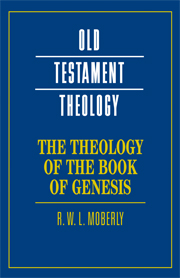Book contents
- Frontmatter
- Contents
- General Editors' Preface
- Preface
- List of Abbreviations
- 1 WHAT IS A “THEOLOGY OF GENESIS”?
- 2 ON READING GENESIS 1–11
- 3 GENESIS 1: PICTURING THE WORLD
- 4 GENESIS 2–3: ADAM AND EVE AND “THE FALL”
- 5 GENESIS 4: CAIN AND ABEL
- 6 GENESIS 6–9: CATACLYSM AND GRACE
- 7 ON READING GENESIS 12–50
- 8 GENESIS 12:1–3: A KEY TO INTERPRETING THE OLD TESTAMENT?
- 9 GENESIS 12:3A: A BIBLICAL BASIS FOR CHRISTIAN ZIONISM?
- 10 GENESIS 22: ABRAHAM – MODEL OR MONSTER?
- 11 ABRAHAM AND THE “ABRAHAMIC FAITHS”
- 12 GENESIS 37–50: IS JOSEPH WISE?
- Further Reading
- Author Index
- Scripture Index
- Subject Index
4 - GENESIS 2–3: ADAM AND EVE AND “THE FALL”
Published online by Cambridge University Press: 05 June 2012
- Frontmatter
- Contents
- General Editors' Preface
- Preface
- List of Abbreviations
- 1 WHAT IS A “THEOLOGY OF GENESIS”?
- 2 ON READING GENESIS 1–11
- 3 GENESIS 1: PICTURING THE WORLD
- 4 GENESIS 2–3: ADAM AND EVE AND “THE FALL”
- 5 GENESIS 4: CAIN AND ABEL
- 6 GENESIS 6–9: CATACLYSM AND GRACE
- 7 ON READING GENESIS 12–50
- 8 GENESIS 12:1–3: A KEY TO INTERPRETING THE OLD TESTAMENT?
- 9 GENESIS 12:3A: A BIBLICAL BASIS FOR CHRISTIAN ZIONISM?
- 10 GENESIS 22: ABRAHAM – MODEL OR MONSTER?
- 11 ABRAHAM AND THE “ABRAHAMIC FAITHS”
- 12 GENESIS 37–50: IS JOSEPH WISE?
- Further Reading
- Author Index
- Scripture Index
- Subject Index
Summary
Few, if any, portions of the Old Testament have been more influential on historic Christian theology than the story of Adam and Eve in the Garden of Eden in Genesis 2–3. Although in recent years the story has received any number of readings of a remarkably diverse kind (which I cannot begin to enumerate or analyze here), the classic construal of the story in terms of “the Fall” of humanity retains a certain primacy in Christian thinking. So, this will be the focus here.
It is sometimes pointed out, usually in implicit or explicit critique of the classic significance of the narrative, that the Old Testament itself appears to make no use of the story – with the implication that therefore it could not really be that important within the Old Testament, and therefore perhaps should not really feature in theological use of the Old Testament in the way it often has. Such an observation, however, is largely beside the point and tends to confuse the task of a history of religious thought with the task of constructive theological interpretation of scripture. Internal cross reference within the Old Testament is not necessarily a good guide to intrinsic significance. The oneness of God as proclaimed in the Shema (Deut 6:4) appears to be cited within the Old Testament only once (Zech 14:9), yet the instincts of historic Judaism to fix on the Shema as a keynote text are surely entirely sound. Similarly, the location of Genesis 2–3 at the very outset of the Old Testament, with the first interactions between God and humanity, gives a contextual weight to the narrative that is as great as could be.
- Type
- Chapter
- Information
- The Theology of the Book of Genesis , pp. 70 - 87Publisher: Cambridge University PressPrint publication year: 2009



